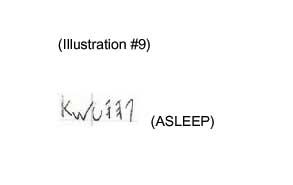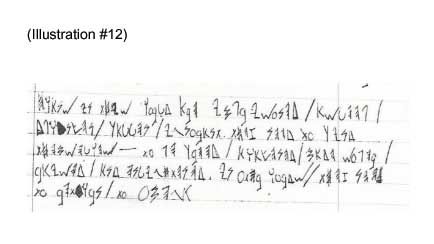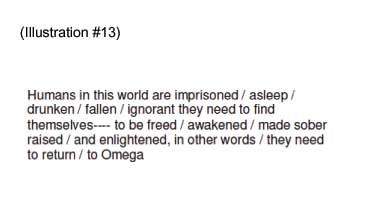Deciphering gang codes requires inspiration and sometimes a lot of perspiration too. This case study will demonstrate that sometimes the solution to deciphering a code takes several attempts. As I examined this document, the first thing that I noticed, was that the first line and third line of this document are identical (Illustration #1).
Then I noticed that in the fourth line, there was a four-character word with double letters (Illustration #2).
The symbol pattern for this word would look like “YXXZ”, where “X” is the same letter. Words that would fit this pattern include: BEEN, SEEN, NEED, SEED, TOOL, FOOL, etc.
Then I saw, in the second line, a four-character word that used the same symbols, but the first and second symbols were reversed (Illustration #3).
The symbol pattern for this second symbol pattern would look like “XYXZ” again where “X” is the same letter. These two sets of symbols could help to decipher this code, if I could find a four letter word that worked in both symbol patterns.
Using the words we identified as possible four-letter words to see if they work in this pattern would look like: BEEN / EBEN; SEEN / ESEN; NEED / ENED; SEED / ESED; TOOL / OTOL; FOOL / OFOL. I have illustrated only a few of the possible four-letter words that I tried. Some words seemed to work, like: ABBY / BABY; DOOR / ODOR; VEER / EVER, but when I tried those letters in the rest of the document, I found that they did not work…
As this door seemed to close, I took a closer look at the document and noticed several three-symbol words located on the first, second and third line, and the first and third line symbols were identical (Illustration #4).
I tried several common three-letter words and found that (Illustration #5) was the word “ARE” and (Illustration #6) was the word “AND”.
My next step was to try to identify other words and verify the letters I had identified. On line four, I found another symbol group with double letters and I noticed the last word on line one (and line three) also had double letters (Illustration #7).
I found that the symbols in (Illustration #8), was the word “FALLEN” and the symbols in (Illustration #9) was the word “ASLEEP”.

These words enabled me to create the following symbol template which identifies the symbols used in this code (Illustration #10).
While trying to decipher and then translate this document, there seemed to be some confusion on the part of the writer, suggesting that this is either a code he is learning or trying to create. Look at the bottom of this document (Illustration #1) and you will see that the writer experimented with using these code symbols vertically (Illustration #11).
Remember the four-symbol group words shown in (Illustration #3)? The door that closed on my attempt to decipher this code? Well, the second line which appears to be some kind of “practice line” begins with the four-symbol word that turned out to be “ENED” and the other four-symbol word with double letters in the same illustration is “NEED”. Since there is no word “ENED” in English, I couldn’t make those letters work for those symbols. The writer was probably writing the end of the word “AWAKENED”, a word which is used in the second paragraph.
The second paragraph is the most coherent paragraph (Illustration #12) and is shown translated and transcribed in (Illustration #13).


This document presented a challenge to decipher. I quickly found a symbol pattern that I thought would help to decipher this code…but it was a door that never opened because the writer of this document seemed to be either learning or creating these code symbols. In addition, there are spelling and grammatical errors throughout the document.
But, when one door closes…












